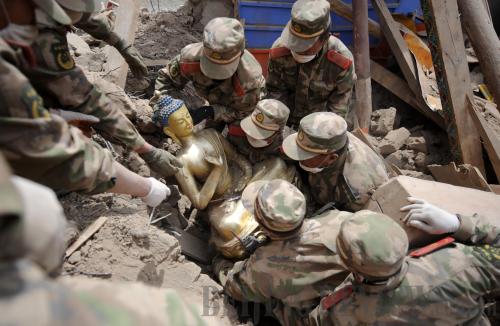The cultural relics seriously damaged by a devastating earthquake in Yushu of China's Qinghai in April 2010 are being restored.

TAKING CARE: Soldiers of the Chinese People's Armed Police Force dig out a Buddhist statue from rubble at the Thrangu Monastery in Yushu Tibetan Autonomous Prefecture in northwest China's Qinghai Province on April 19, 2010 (NIE JIANJIANG)
Besides leaving at least 2,600 people dead and more than 100,000 homeless, the 7.1-magnitude earthquake, which jolted the Yushu Tibetan Autonomous Prefecture in northwest China's Qinghai Province on April 14, 2010, seriously damaged large numbers of the area's cultural relics.
Five national-level and 23 provincial-level cultural relic sites in Qinghai and neighboring Sichuan Province were shattered during the quake, said Guan Qiang, Deputy Director of the Department of Cultural Heritage Conservation and Archaeology of the State Administration of Cultural Heritage (SACH), in Beijing on May 27, 2010.
The SACH investigated an area of 300,000 square km, which covers seven counties rocked by the quake in the two provinces, the administration said.
Most of the damaged cultural relics were Tibetan Buddhist monasteries and other religious places like the Gyana Mani Stone Mound in Sengza Village near Gyegu Town of the prefecture, the epicenter of the quake.
"This means we must take religious and ethnic elements into consideration when carrying out restoration work," Guan said.
Severely damaged
The Yushu Tibetan Autonomous Prefecture boasts beautiful scenery, legends, and rich Tibetan culture. As the source of China's three major rivers—the Yellow River, the Yangtze River and the Lancang River, the prefecture contains the world's largest mani stone mound, a Kham culture museum and many Tibetan Buddhist monasteries and stupas.
"Most of the prefecture's monasteries collapsed, including the 700-year-old Thrangu Monastery and the 2,000-year-old Gyegu Monastery," said Guo Hong, Deputy Director of the Qinghai Provincial Bureau of Cultural Heritage.
The Thrangu Monastery is the biggest monastery of the Kagyu Sect of Tibetan Buddhism in Yushu Tibetan Autonomous Prefecture and has a huge collection of Buddhist scriptures. During the quake, Thrangu was the hardest hit of all monasteries in the prefecture.
China National Radio reported 31 of 260 monks at the monastery died and another 27 were injured.
The main hall came to the verge of collapse because of cracked walls, while surrounding buildings, including the bedrooms of the monks, two meditation centers and at least three other halls were reduced to rubble, said the report.
Many cultural relics including Buddist scriptures, statues, tangka and Tibetan scroll paintings, were buried under the rubble. A tangka is a form of traditional Tibetan painting or embroidery on silk, paper or other materials, usually depicting a Buddhist deity, famous scene or mandala.
The Gyegu Monastery, the largest Tibetan Buddhist monastery in the prefecture, was ruined.
"The scripture hall, with a history of more than 500 years, was totally destroyed, and eight of 500 monks there lost their lives," said a 35-year-old monk who is responsible for managing the hall in an article of Guangzhou Daily.
Besides the scripture hall, the main body of the institute of Buddhism learning collapsed and the stupas were completely ruined.
The Gyana Mani Stone Mound in the prefecture's Yushu County, a holy place to local Tibetans and the largest of its kind in the world, was reduced to a chaotic tangle of rubble by the quake .
The site consists of a mani stone mound, two prayer halls, 490 prayer wheels and 14 pagodas. Three pagodas collapsed and cracks were visible in others.
The 1,300-year-old Temple of Princess Wencheng in Yushu County was not greatly affected in the quake, but the stone cliff behind its main hall has begun to crack, threatening the structure.
